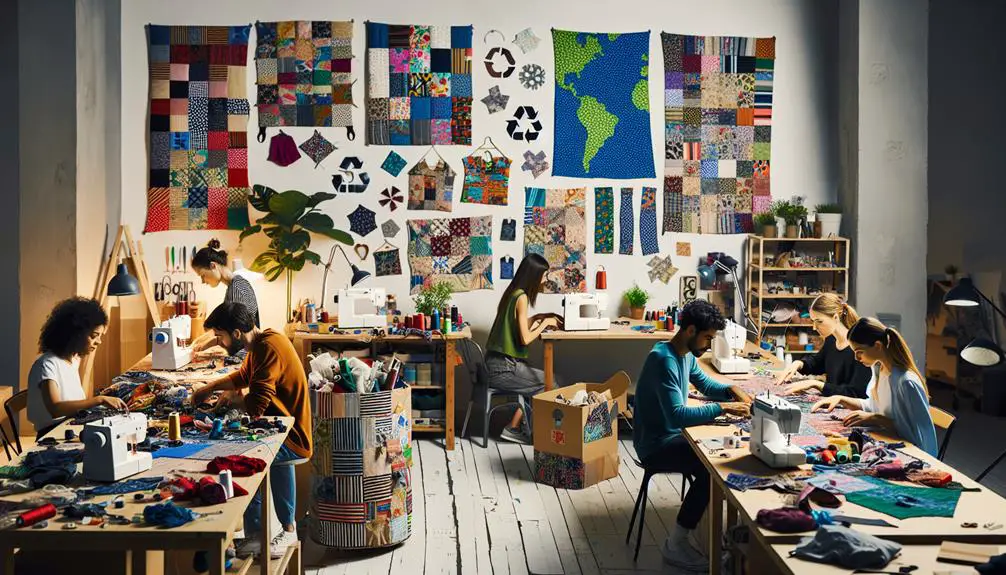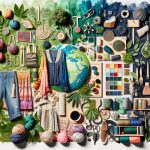Imagine designing clothing patterns that fit together like a jigsaw puzzle, leaving almost no leftover fabric—this is zero-waste pattern making. It's just one of the innovative solutions reshaping the textile industry. You might be curious about how other methods, like upcycling and advanced fabric recycling technologies, contribute to minimizing waste. By exploring these practices, you'll discover how sustainable material sourcing and circular fashion models are changing the way we think about fabric waste. And, there's more to learn about how consumer education empowers you to make a difference.
Table of Contents
Key Takeaways
- Zero-Waste Pattern Making: Efficiently utilizes fabric by designing patterns that fit together like puzzle pieces, minimizing waste.
- Upcycling Techniques: Creatively transform old materials into new, useful items, such as trendy garments or patchwork projects, reducing waste.
- Advanced Sorting Technologies: Use AI and automated systems for precise sorting, enhancing recycling yields and minimizing contamination.
- Chemical Recycling Methods: Break down textiles into original fibers, transforming discarded fabrics into valuable raw materials while maintaining material integrity.
- Sustainable Material Sourcing: Opt for organic, recycled, and locally sourced fabrics, and seek certifications to support eco-friendly and responsible textile practices.
Zero-Waste Pattern Making
Zero-waste pattern making is an innovative approach that guarantees every inch of fabric is utilized efficiently. By mastering this technique, you contribute significantly to sustainable design and waste reduction.
Instead of traditional patterns that leave scraps behind, zero-waste methods involve designing patterns that fit together like puzzle pieces. This ensures no fabric goes to waste, maximizing the material's potential.
To excel in zero-waste pattern making, you need to rethink how you approach design. Start by visualizing the entire fabric as a canvas. Every cut and stitch should be planned meticulously. This not only reduces waste but also challenges your creativity and problem-solving skills.
Consider the garment's shape, size, and construction from the outset, ensuring that each component integrates seamlessly.
Fabric Recycling Technologies
You should explore the latest fabric recycling technologies to tackle textile waste effectively.
Advanced sorting techniques can distinguish between various fabric types, while chemical recycling methods break down fibers for reuse.
These innovations make a significant impact on reducing waste.
Advanced Sorting Techniques
Advanced sorting techniques play a vital role in enhancing the efficiency and effectiveness of fabric recycling technologies. By leveraging automated sorting and AI technology, you can greatly reduce the time and labor required to separate different types of textiles. Automated sorting systems use advanced sensors and machine learning algorithms to identify and categorize fabrics based on their material composition, color, and even texture. This precise sorting ensures that each type of fabric is correctly processed, minimizing contamination and maximizing recycling yields.
When you utilize AI technology, you gain the ability to analyze vast amounts of data quickly and accurately. AI algorithms can learn from previous sorting tasks, continuously improving their accuracy over time. This adaptability is important for handling the ever-changing landscape of textile waste, which includes a wide variety of fabrics and blends. Through this advanced sorting, you not only streamline the recycling process but also enhance the quality of the recycled materials.
Incorporating these advanced techniques into your fabric recycling operations can lead to more sustainable practices, reduced waste, and ultimately, a smaller environmental footprint. By mastering these technologies, you're positioning yourself at the forefront of innovative and efficient fabric recycling.
Chemical Recycling Methods
Harnessing chemical recycling methods offers a promising approach to breaking down complex textile blends into their original fibers for reuse. By utilizing advanced chemical recovery processes, you can transform discarded fabrics into valuable raw materials, making a substantial contribution to textile regeneration. This method excels where traditional mechanical recycling falls short, especially with mixed-material textiles that are otherwise challenging to repurpose.
Chemical recycling involves breaking down the polymers in textiles to their monomer states. This polymer recycling not only maintains the integrity of the original materials but also facilitates waste reduction by converting what would be landfill-bound fabric into reusable fibers. Imagine the impact: garments made from chemically recycled fibers can match the quality and durability of those produced from virgin materials.
To master this innovative technique, you need to understand the specific chemicals and processes involved, such as solvolysis and depolymerization. As you explore further, you'll discover that these methods can handle various types of textiles, from polyesters to nylons, efficiently separating and reclaiming them.
Upcycling Techniques
Upcycling offers a fantastic way to reduce fabric waste by turning old materials into something new and useful.
You can start with creative patchwork projects or transform outdated garments into trendy, unique pieces.
These techniques not only save fabric but also add a personalized touch to your wardrobe.
Creative Patchwork Projects
Turning fabric remnants into beautiful patchwork projects is an enjoyable and eco-conscious approach to reduce waste. By participating in scrap quilting, you can craft unique quilted cushions that not only enhance your living space but also contribute to a sustainable way of life.
Begin by categorizing your fabric remnants by color and texture. This organization enables you to visualize the final product more vividly and facilitates the sewing process.
Subsequently, select a patchwork design that matches your proficiency level. Whether you're a novice or an expert quilter, there's a pattern that will stimulate and motivate you. After choosing your design, cut your fabric remnants into the necessary shapes. Accuracy is crucial at this stage; precise cutting guarantees that your pieces fit together seamlessly.
While sewing the pieces together, uphold a uniform seam allowance. This minor aspect can have a significant impact on the ultimate look of your quilted cushions. Remember to iron your seams as you progress, as this aids in keeping everything smooth and in line.
Lastly, include a backing fabric and some padding for added comfort and longevity. By adhering to these guidelines, you'll excel in the craft of scrap quilting and produce exquisite, eco-friendly home furnishings.
Transforming Old Garments
Don't let your old garments gather dust when you can breathe new life into them with creative upcycling techniques. Transforming old clothes isn't just about reducing waste; it's a chance to express your unique style and craftsmanship. Through garment refurbishment, you can take a beloved but worn-out piece and make it look brand new.
Think about adding patches, changing buttons, or even dyeing the fabric to give it a fresh look.
Textile repurposing allows you to turn outdated clothing into something entirely different. For instance, an old pair of jeans can become a trendy tote bag or a stylish skirt. This kind of fashion reimagining not only saves fabric from ending up in landfills but also provides you with custom, one-of-a-kind pieces.
Clothing reconstruction involves taking parts of various garments and combining them to create something innovative. Imagine merging the sleeves of one shirt with the body of another to craft a statement piece.
Digital Fabric Cutting
Digital fabric cutting transforms the textile industry by reducing waste through precise and efficient material usage. When you employ automated precision in your fabric cutting processes, you'll find that each piece is cut with exacting accuracy, minimizing the amount of leftover material. This technology doesn't just enhance the efficiency of production; it also ensures consistent quality, which is vital for producing high-end garments.
Imagine having a system that optimizes every inch of fabric, creating intricate patterns with minimal waste. Automated cutting machines use advanced software to map out the most efficient layout for each piece. This process not only saves you time but also greatly reduces the environmental impact of your production line.
You'll appreciate how digital fabric cutting eliminates human error, a common source of waste in traditional methods. With this technology, you can streamline operations, maintain superior quality, and contribute to a more sustainable fashion industry.
Mastery of digital fabric cutting means you're at the forefront of innovation, making your production process not just more efficient, but also more responsible. Embrace this cutting-edge technology to transform your approach to fabric utilization and waste reduction.
Sustainable Material Sourcing
After optimizing your fabric cutting processes, the next step in reducing fabric waste is to focus on sourcing sustainable materials. This involves selecting fabrics that are produced through ethical sourcing and eco-friendly options. By choosing these materials, you not only minimize waste but also support responsible practices within the textile industry.
Here are four key strategies to contemplate:
- Organic Fabrics: Opt for organic cotton, hemp, or bamboo. These materials are grown without harmful pesticides and chemicals, making them more environmentally friendly and safer for workers.
- Recycled Materials: Look for fabrics made from recycled fibers. These can include recycled polyester or nylon, which reuse waste materials and decrease the reliance on virgin resources.
- Certifications: Seek out textiles that have been certified by reputable organizations such as GOTS (Global Organic Textile Standard) or OEKO-TEX. These certifications guarantee that the materials meet strict environmental and social standards.
- Local Sourcing: Whenever possible, source materials locally. This reduces the carbon footprint associated with transportation and bolsters the local economy.
Circular Fashion Models
Embracing circular fashion models can greatly reduce fabric waste by designing clothes that have a longer lifecycle, are easier to recycle, and can be repurposed. You can make a significant impact by supporting brands that utilize sustainable production and closed loop systems. Circular fashion focuses on designing products that never truly become waste. Instead, they are constantly cycled back into the production process.
Consider the following aspects of circular fashion models:
| Aspect | Benefit |
|---|---|
| Design for Longevity | Extends the lifecycle of garments |
| Recycling Methods | Simplifies converting old to new fibers |
| Repurposing | Reduces the need for virgin materials |
By prioritizing design for longevity, you guarantee that garments remain functional and stylish for longer periods. This reduces the frequency of disposal and the demand for new raw materials. Recycling methods facilitate the transformation of old fabrics into new textiles, closing the loop and minimizing waste. Repurposing garments creatively can breathe new life into old pieces, further extending their usefulness.
When you choose to support circular fashion models, you're playing an active role in fostering a more sustainable production process. This not only helps the environment but also promotes a more responsible and ethical fashion industry.
Consumer Education Programs
Educating consumers about sustainable fashion practices can greatly enhance the impact of circular fashion models. You play an essential role in waste reduction by making informed choices. By understanding the importance of eco-friendly alternatives, you can significantly contribute to minimizing textile waste.
Here's how consumer education programs can empower you:
- Awareness Campaigns: These campaigns inform you about the environmental impact of textile waste and the benefits of choosing sustainable options. Knowledge is your first step towards making eco-conscious decisions.
- Workshops and Seminars: Participating in these events provides hands-on experience in identifying sustainable materials, upcycling old garments, and learning repair techniques. You'll gain practical skills to extend the life of your clothing.
- Certifications and Labels: Learn to recognize certifications like GOTS (Global Organic Textile Standard) and Fair Trade, which assure you that the products meet certain eco-friendly standards. This knowledge helps you make informed purchases.
- Digital Platforms: Utilize apps and websites that offer information on brands committed to sustainable practices. These platforms often provide tips on how to reduce your fashion footprint.
Frequently Asked Questions
How Can Small Fashion Brands Contribute to Reducing Fabric Waste?
You can reduce fabric waste by adopting eco-friendly initiatives and sustainable sourcing practices. Focus on using recycled materials, optimizing patterns to minimize scraps, and collaborating with suppliers committed to reducing their environmental impact.
What Are the Economic Benefits of Reducing Fabric Waste for Manufacturers?
Imagine slashing your expenses dramatically! Reducing fabric waste leads to massive cost savings and increased efficiency. You'll streamline production, maximize resources, and boost your bottom line, giving you a competitive edge in the market.
How Does Fabric Waste Impact Water Consumption in Textile Production?
You'll find that fabric waste greatly boosts water consumption in textile production. Reducing waste minimizes water usage, ultimately leading to more efficient resource management and lower environmental impact, aligning with your goal of industry mastery.
Are There Government Incentives for Companies to Adopt Fabric Waste Reduction Practices?
Yes, there are government incentives encouraging companies to adopt fabric waste reduction practices. By leveraging these incentives, you can enhance corporate responsibility, reduce costs, and contribute to a more sustainable and efficient textile industry.
How Can Consumers Identify Brands Committed to Reducing Fabric Waste?
Imagine a detective finding clues. You can identify brands committed to reducing fabric waste by looking for brand certifications and evidence of sustainable sourcing. Check for certifications like GOTS or OEKO-TEX, signaling genuine efforts.
- How Does Ring Spun Cotton Affect Garment Fit and Shape Retention? - August 13, 2024
- What Are the Challenges in Producing Ring Spun Cotton? - August 13, 2024
- Is Ring Spun Cotton Suitable for Plus-Size Clothing? - August 13, 2024






